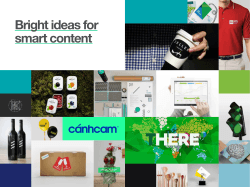
CHAPTER 11 BUILDING BRANDS WITH THE INTERNATIONAL MARKETING MIX part four: managing marketing
part four: managing marketing CHAPTER 11 BUILDING BRANDS WITH THE INTERNATIONAL MARKETING MIX an opening challenge You are the marketing manager for a wellknown designer fashion brand. A chain store has approached your company with a view to placing a large order. The finance manager is delighted and is prepared to discount the price. However, the managing director has some concerns. Do you think this order should be accepted? Do you want to impose any special terms and conditions? agenda • marketing mix objectives • revisiting the marketing mix – integrating the marketing mix – internationalising the marketing mix • packaging • branding a hierarchy of objectives corporate objectives marketing objectives product objectives e.g. to develop a new range promotion place objectives objectives e.g. to e.g. to recruit change new dealers attitudes to a brand price objectives e.g. to undercut competitors the extended marketing mix a well‐designed marketing mix should: • • • • achieve marketing objectives meet customers’ needs create competitive advantage be well integrated (with each element supporting the others) • fit within the available marketing resources integration example upmarket clothing brand • high-quality products • premium prices • for sale in exclusive stores – grand servicescapes • smart, fashionably dressed sales staff • alterations service available • tasteful, creative adverts in style magazines – and magazine spreads product perceived augmented delivery basic image features service support core quality brand identity peripheral products value products sold internationally • basic, augmented and perceived products may vary – core is often the same • may be at different product life cycle stages • are affected by country-specific PRESTCOM + CCC factors – especially laws and regulations, cultural factors influencing product use, income levels, availability of support services promotion: major tools • • • • • • • • advertising PR wom/viral sales promotion personal selling packaging direct marketing communications sponsorship international promotion • strategy may be global – details may need to be country-specific • local scenes and actors may help audience relate to the product advertised • affected by country-specific PRESTCOM + CCC factors – especially language and other cultural factors, laws and regulations, the availability of technology, media habits example marketing channel fabric and trim suppliers customer manufacturer fashion stores import agent wholesaler international distribution • export or manufacture abroad? – indirect or direct export? • appointment of intermediaries – agents, distributors, licensees, franchisees • affected by country-specific PRESTCOM + CCC factors – especially different infrastructures, distribution networks, logistics, transport facilities price: a measure of value? goods/services buyer value price opportunity cost seller international prices • currency – fluctuations can cause significant losses or gains • additional costs – export, transport, agents’ fees • affected by country-specific PRESTCOM + CCC factors – especially income levels, inflation/deflation, import laws, financial regulations, competitors’ pricing, currencies packaging: the 5th P? • multi function – – – – protection adding value to product communication the silent salesman on the shelf • the brand’s visual identity • a valuable asset • an environmental nightmare the fifth P? product promotion place price international packaging considerations include: • laws and regulations – e.g. composition, recycling • culture – e.g. language, common usage, colours • education and literacy levels – e.g. impact on instructions • protection during transport – maybe over longer distances services marketing mix branding • brand image - identity, personality, values • brand equity • brand types • branding strategies • brand loyalty the brand’s personality shapes its brand identity which helps create a brand image brand equity • a good brand is a valuable asset – but the value is hard to measure – takeover bids, price premiums • indicators of high brand equity include: – high price, high distribution intensity, a pleasant shopping environment , a large advertising budget (Yoo et al., 2000) brand types corporate umbrella range individual own-label (private) generic all products use e.g. Heinz corporate name groups of products e.g. Taste the share a brand name Difference (Sainsbury’s) each product has its e.g. Bold (Procter own brand name & Gamble) products bear the e.g. Tesco retailer’s (or wholesaler's) name product name only e.g. aspirin brand architectures and strategies • branded house – single master brand, e.g. Virgin • house of brands – suite of stand-alone brands, e.g. Diageo • new product launches – line extension – brand extension – brand stretch • co-branding brand loyalty • loyal customers consistently choose the brand – and go out of their way to buy it • they are more valuable than repeat customers – positive word of mouth – longevity • loyalty has to be earned – an emotional bond based on trust – customer satisfaction is essential summary • is packaging the 5th P? – or does it cut across the marketing mix? • marketing mix may need to be varied overseas – the core benefit may be the same • well-integrated 7Ps can help build brands – brand image – brand loyalty – brand longevity and profitability reference • Yoo, B., Donthu, N. and Lee, S. (2000) 'An examination of selected marketing mix elements and brand equity', Academy of Marketing Science, 28(2): 195–211.
© Copyright 2025









